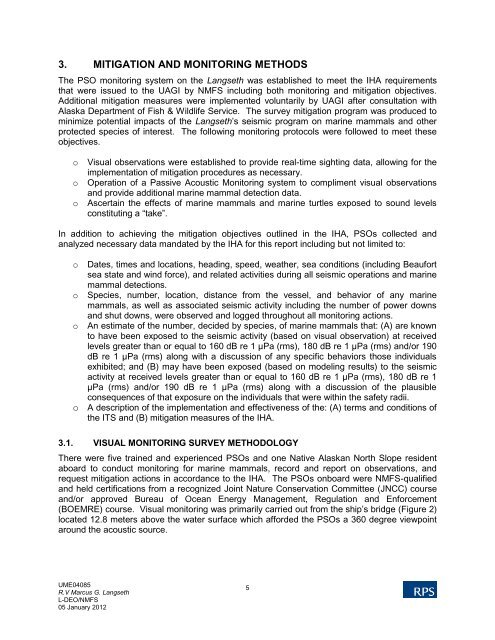90-day Monitoring Report - National Marine Fisheries Service - NOAA
90-day Monitoring Report - National Marine Fisheries Service - NOAA
90-day Monitoring Report - National Marine Fisheries Service - NOAA
You also want an ePaper? Increase the reach of your titles
YUMPU automatically turns print PDFs into web optimized ePapers that Google loves.
3. MITIGATION AND MONITORING METHODS<br />
The PSO monitoring system on the Langseth was established to meet the IHA requirements<br />
that were issued to the UAGI by NMFS including both monitoring and mitigation objectives.<br />
Additional mitigation measures were implemented voluntarily by UAGI after consultation with<br />
Alaska Department of Fish & Wildlife <strong>Service</strong>. The survey mitigation program was produced to<br />
minimize potential impacts of the Langseth’s seismic program on marine mammals and other<br />
protected species of interest. The following monitoring protocols were followed to meet these<br />
objectives.<br />
o Visual observations were established to provide real-time sighting data, allowing for the<br />
implementation of mitigation procedures as necessary.<br />
o Operation of a Passive Acoustic <strong>Monitoring</strong> system to compliment visual observations<br />
and provide additional marine mammal detection data.<br />
o Ascertain the effects of marine mammals and marine turtles exposed to sound levels<br />
constituting a “take”.<br />
In addition to achieving the mitigation objectives outlined in the IHA, PSOs collected and<br />
analyzed necessary data mandated by the IHA for this report including but not limited to:<br />
o Dates, times and locations, heading, speed, weather, sea conditions (including Beaufort<br />
sea state and wind force), and related activities during all seismic operations and marine<br />
mammal detections.<br />
o Species, number, location, distance from the vessel, and behavior of any marine<br />
mammals, as well as associated seismic activity including the number of power downs<br />
and shut downs, were observed and logged throughout all monitoring actions.<br />
o An estimate of the number, decided by species, of marine mammals that: (A) are known<br />
to have been exposed to the seismic activity (based on visual observation) at received<br />
levels greater than or equal to 160 dB re 1 µPa (rms), 180 dB re 1 µPa (rms) and/or 1<strong>90</strong><br />
dB re 1 µPa (rms) along with a discussion of any specific behaviors those individuals<br />
exhibited; and (B) may have been exposed (based on modeling results) to the seismic<br />
activity at received levels greater than or equal to 160 dB re 1 µPa (rms), 180 dB re 1<br />
µPa (rms) and/or 1<strong>90</strong> dB re 1 µPa (rms) along with a discussion of the plausible<br />
consequences of that exposure on the individuals that were within the safety radii.<br />
o A description of the implementation and effectiveness of the: (A) terms and conditions of<br />
the ITS and (B) mitigation measures of the IHA.<br />
3.1. VISUAL MONITORING SURVEY METHODOLOGY<br />
There were five trained and experienced PSOs and one Native Alaskan North Slope resident<br />
aboard to conduct monitoring for marine mammals, record and report on observations, and<br />
request mitigation actions in accordance to the IHA. The PSOs onboard were NMFS-qualified<br />
and held certifications from a recognized Joint Nature Conservation Committee (JNCC) course<br />
and/or approved Bureau of Ocean Energy Management, Regulation and Enforcement<br />
(BOEMRE) course. Visual monitoring was primarily carried out from the ship’s bridge (Figure 2)<br />
located 12.8 meters above the water surface which afforded the PSOs a 360 degree viewpoint<br />
around the acoustic source.<br />
UME04085<br />
R.V Marcus G. Langseth<br />
L-DEO/NMFS<br />
05 January 2012<br />
5
















